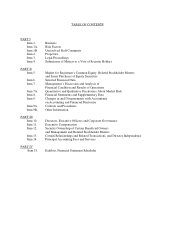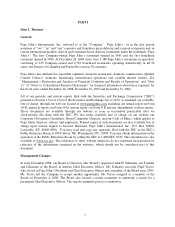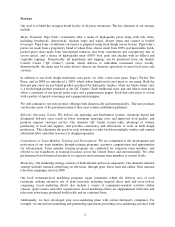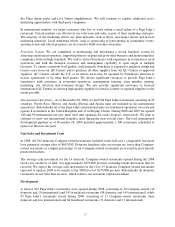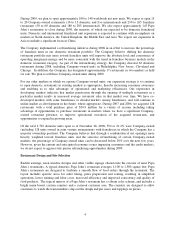Papa Johns 2008 Annual Report Download - page 17
Download and view the complete annual report
Please find page 17 of the 2008 Papa Johns annual report below. You can navigate through the pages in the report by either clicking on the pages listed below, or by using the keyword search tool below to find specific information within the annual report.10
• For the first six months of 2009, suspending collection of the 0.25% royalty rate increase that
was scheduled for January 2009 with the effect that the royalty rate will remain at 4.25% for the
first six months of 2009 (with the Company deciding whether to continue to suspend collection
of the royalty rate increase at mid-year).
With respect to the BIBP cheese cost relief for 2009, for the first two months of the year the price per
pound was set at a level approximately equal to the Q4-08 modified price, and substantially less than the
price as would have been determined by the standard formula. Effective in March 2009, we will modify
the BIBP formula to establish the price of cheese on a more frequent basis at the projected spot market
price plus a certain mark-up. The amount of the mark-up depends on the projected spot market prices.
The modification of the BIBP formula in 2008 and 2009 could delay the recoupment of the BIBP deficit.
However, the Franchise Advisory Council has acknowledged a domestic system responsibility to
continue to buy cheese from our QC Centers so long as the BIBP cheese purchasing entity remains in a
deficit position. Under this new price formula, we anticipate BIBP will substantially repay its cumulative
deficit by the end of 2011.
The Company estimates the gross incremental impact of these and certain other support initiatives and
non-recurring costs on the Company’s operating income, excluding the impact of consolidating BIBP’s
operating results, to be $12.0 million to $14.0 million for 2009 (excluding any favorable impact to sales
and profits resulting from the increased marketing).
The Company believes the support program will produce long-term shareholder value for the Papa John's
system by mitigating potential unit closures and strengthening our brand during this challenging
economic environment. In addition to reducing unit closures, other important objectives of the support
program include growing market share in a consolidating category, stabilizing transaction levels and
targeting a substantial multi-year increase in online ordering percentage.
International Development and Franchise Agreements. We opened our first franchised restaurant
outside the United States in 1998. We define “international” to be all markets outside the contiguous
United States in which we have either a development agreement or a master franchise agreement with a
franchisee for the opening of a specified number of restaurants within a defined period of time and
specified geographic area. Under a master franchise agreement, the franchisee has the right to
subfranchise a portion of the development to one or more subfranchisees approved by us. Under our
current standard international development agreement (except for Hawaii and Alaska, in which the initial
fees are the same as for domestic restaurants), the franchisee is required to pay total fees of $25,000 per
restaurant: $5,000 at the time of signing the agreement and $20,000 when the restaurant opens or the
agreed-upon development date, whichever comes first. Under our current standard master franchise
agreement, the master franchisee is required to pay total fees of $25,000 per restaurant owned and
operated by the master franchisee, under the same terms as the development agreement, and $15,000 for
each subfranchised restaurant -- $5,000 at the time of signing the agreement and $10,000 when the
restaurant opens or the agreed-upon development date, whichever comes first.
Our current standard international master franchise and development agreement provides for payment to
us of a royalty fee of 5% of sales (3% of sales by subfranchised restaurants), with no provision for
increase during the initial term. The remaining terms applicable to the operation of individual restaurants
are substantially equivalent to the terms of our domestic franchise agreement. From time to time,
development agreements will be negotiated at other than standard terms for fees and royalties.
Non-traditional Restaurant Development. We have entered into a limited number of development and
franchise agreements for non-traditional restaurants. For example, a total of 17 franchised net units
opened in Six Flags theme parks in 2006, 2007 and 2008 as part of a five-year marketing and partnership


